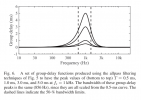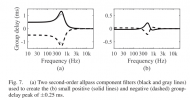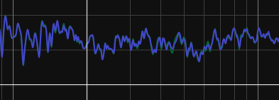Doesn't matter to me if you believe any of my graphs or subjective listening test results.
Science is about objective proofs, religion is about beliefs.
Doesn't matter to me if you believe any of my graphs or subjective listening test results.
When I’m producing music on my Amphion One15s I am able to more clearly hear the differences between compressor settings than on my KH120s. These monitors are being used in the near field about 75cm from my ears.
SSL compressors have an attack knob that ranges from 0.1ms up to 30ms in steps. Minute adjustments are more easily perceived on the One15s.
I don’t put the difference between the two monitors in highlighting timing changes down to their frequency response.
Most of the phase correction is due to the phase deviation caused by passive XO. Luckilly, those deviations are practially inaudible, at least in a room with "normal" reflections.
I believe the phase shifts by passive xovers are audible, or rather the lack of phase shifts is audible
Believe is not the reality. Abx succeeded and you will be famous.I believe the phase shifts by passive xovers are audible, or rather the lack of phase shifts is audible
Believe is not the reality. Abx succeeded and you will be famous.
You can try with rePhase.
I believe the phase shifts by passive xovers are audible, or rather the lack of phase shifts is audible
Passive XO phase shift has been proven by blind tests to be inaudible,
again, the crossover is not the problem.
this is the group delay of a typical system, and anybody can hear the diference in the video, because I can even on a smart-phone
In so far as the passive xo is the cause of the added group delay, one cannot really separate or exclude it anyway.
is it realy the cause? cause a traditional XO at 1000Hz adds only about 1ms
One should be careful not to create new myths.But yes, even the xo of the KH120 itself, for example, at 2kHz GD is less than a ms yet correcting for it is audible to me (ABX test results I attached in previous page).



One should be careful not to create new myths.
The audibility of group delay in the low bass should be quite indisputable, since one can expect 10-20ms group delay depending on the speaker design principle (CB, BR, PR,...) and crossover frequency. There are also here in the forum ABX examples of group delay change (almost) without FR change, where one can check this.
The audibility of group delay in the midrange and treble caused by crossover is quite another matter.
Current studies clearly contradict the statement that these are audible with common filter slopes.
A fourth order Linkwitz-Riley crossover (of a typical 2-Way speaker) shows a group delay well below 0.5ms down to 200Hz.
View attachment 156618
A recent study "AUDIBILITY OF GROUP-DELAY EQUALIZATION, LISKI et al." investigates the audibility of group delay in the range +-0.25ms to +-5ms in the frequency range 500-4000Hz.
The used group delay curves are much more challenging than the group delay curve of a LR4 crossover (see above, right diagram, black curve).
View attachment 156620 View attachment 156621
Artificial and natural signals were evaluated. Even if the lowest individual hearing threshold of an artificial signal is taken at 2 kHz (0.27ms), the group delay of an LR4 crossover (0.23ms) is below the audibility threshold. When using natural signals, the perceptibility threshold is well above the group delay of a standard crossover.
Someone who can hear the group delay in a crossover LR4@2kHz with normal music can, according to the current state of science, join the Avengers - even if the superpower is not likely to do much against Thanos
View attachment 156623
View attachment 156622
In most cases, phase equalization might also lead to a change in the frequency response of the loudspeaker. It is likely that this frequency response change is perceived and not the group delay change.
Someone who can hear the group delay in a crossover LR4@2kHz with normal music can, according to the current state of science, join the Avengers - even if the superpower is not likely to do much against Thanos
perception of volume is somewhat decreased rather than increased
I don't really care too much if it is the [passive] xo itself that is the direct cause of the added group delay
i used rePhase and his Linearization filter with my K+H O300 and my KH 420. The Mid on the both models are in front and quickly unbearable. But it gives a nice step response curve.I don't believe I made extraordinary claims to know what the exact amount of phase shift from the mid and high frequency crossover induced GD does time distortion start to become audible for all individuals. I performed listening tests to hear for myself whether there is an advantage/improvement in correcting the passive xo induced phase rotation in my smaller (non-linear phase) monitors.
The ABX tests were performed using foobar. Pure time correction using rePhase's "minimum phase filters phase linearization" LR4 at 2 kHz plus some minor additional paragraphic phase EQs were used. There is no frequency response EQ applied as well as none seen in the measurements -- zero, nada. Microphone placed at the exact same listening position. Apply frequency dependent windowing, say, 6 cycles or less -- then and only then do we clearly see an increase in the magnitude SPL around the xo region. I have not tested and listened for the audibility the aforementioned pure phase correction in the far-field. The attached test results was performed from less than 1 meter in my nearfield desk setup where much of early first reflections are minimal to absent. I have said before that correcting for this phase/GD/time distortion made vocals and music sound (I did not test pure tones or other noise) a little cleaner and less fatiguing -- i.e. less rough/grainy/grating and where perception of volume is somewhat decreased rather than increased -- I presume this is likely from the reduced GD "time distortion" and maybe a little similar in what we experience when harmonic distortion / resonances are reduced in a speaker cabinet, for example. *AGAIN: the effect was very subtle.
I'll dig out my measurements later (I know it's here in my hard drive somwhere) to show what I mean about magnitude only visibly changing after applying FDW.
Wasn't sure which saved MDAT file I had before so I re-measured my left KH120 (ports are sealed to match its phase with my sealed sub easier). Monitor is played solo with no EQ and the microphone less than a meter from the acoustical axis using 90 deg mic orientation and calibration file
no difference whatsoever
Actually, a difference is visible if FDW is applied.

a difference but what is the cause: eq calculation vs the phase correction ? When i used rePhase i had clipping ...Slight deviations can also be seen in your first measurement. However, these are almost undetectable due to the room resonances.
View attachment 156683
For measurements in normal living rooms, it is usually useful to use the average of several measurements, as this can improve the S/N ratio (noise floor).
To exclude falsifications of the measurement by room influences, these must always be removed from the measurement by gating ("windowing").
REW tries to improve this automatically with the FDW.
It would be even better if you could completely eliminate the room resonances by gating.
Assuming the comparison of the FDW measurements would be correct, you would have the perfect explanation for the perception differences between the "normal" and phase-corrected version (FIR) of the KH120 that you describe.
The FIR version shows a hump of about 0.7dB in the mid-high range between 900Hz and 4kHz. This change in timbre should be audible.
